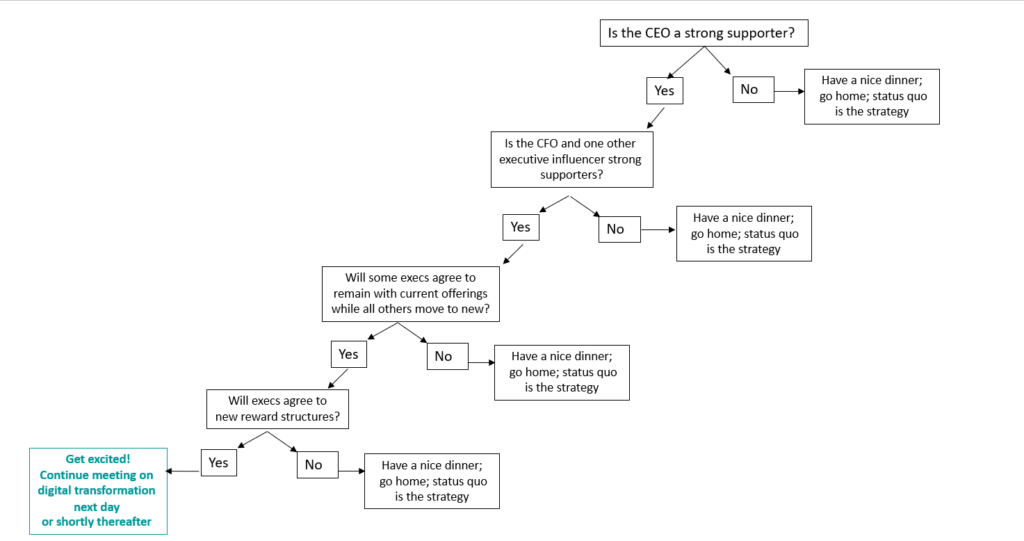Digital Transformation Must Be Top-Down and Inside-Out. CEO or CFO Not Bought In? Enjoy Golf!
Originally published as part of, “The Day Before Digital Transformation” by Phil Perkins and Cheryl Smith
Successful digital transformation occurs when the current leadership team accepts responsibility for the digital vision, strategic direction, and a prioritized portfolio of digital efforts incorporating relevant emerging technologies. Top leaders must state clearly that digital transformation is critical to long-term, and perhaps even short-term, survival. The leaders must be able to effectively communicate the end state vision along with well-thought-out paths for achieving it. The organization must understand that transformation will be evolutionary, not revolutionary.
If these messages are sent appropriately and sincerely, then the chances of organizational acceptance improve dramatically.

But even when logic dictates that changes are needed and step-by-step guides are available showing how to take on the efforts, many leadership teams still are reluctant to take concrete steps. We have heard dozens of reasons why this simply is not the right time to take on digital transformation actions inside the organization:
“This will cannibalize sales.”
“Our customers never asked for this.”
“We need more research.”
“Let’s start small and see.”
“What’s the ROI? I have bigger fish to fry.”
“Fast follower is best strategy. We can quickly catch up later.”
“We are in the middle of adding some great features right now.”
“Great ideas but should delay until timing is better.”
“Huge security risk. Our CISO will never approve.”
“Huge financial risk. Our investors will never approve.”
“The technology will never work.”
“That’s not the business that we are in.”
“We tried this before…”
“Our competition is not doing this.”
“We do not have team, experience, time…”
“This will never get by Regulatory Compliance.”
“This will affect Dept. X, and we need their input.”
We are sure you can add more. Two things are lacking when reasons like these hold back leadership teams: understanding of the consequences of inaction, and believing that your organization has strong advantages that help make the transition successful. We present ways of overcoming such obstacles and inoculating from corporate anti-bodies.
We have addressed the closing window of opportunity in Chapter 1, providing historical proof overlaid with current factual trends. There is little time left for choosing a ‘head in the sand’ strategy. If you do not digitize your products, services, or ways of doing business, someone else will. But we haven’t addressed the reasons why your organization is in a much stronger position than the start-ups that are already working to make your customers/clients/users/patients/guests (whatever you call the consumers of your offerings) away from you.
To be clear, there are start-ups in your industry that are incorporating the emerging technologies into their offerings to compete with you. Even more, start-ups will be funded now that we have entered Phase 3 of the Digital Age. Many traditional organizations do not view them as competitors—until it is too late. Or they feel outgunned because they do not have the new technology experience or expertise.
But established organizations should understand that the advantages they have over digital start-ups are substantial. They provide the firepower for you to compete with, and beat, current and upcoming digital start-ups. Past research and current experience have shown that in a battle between the two, the established organization almost always wins over the start-up. Consider the following:[i]
- The value of having an existing customer relationship has been proven over time. The cost of new customer acquisition is three to five times higher than upselling a current or new product or service from a current provider.
- Although brand recognition is not as important to sales today as it has been in the past, brand reach continues to be a strong advantage. The cumulative history of customer promises kept gives current organizations the benefit of the doubt in times of disruption or crisis.
- Having an established installed base against which to test new products and services and receive valid feedback has proved to be extremely beneficial and cost-effective.
- Established organizations have years of granular data about processes, buying patterns, ROI, etc., that start-ups must either purchase or make decisions about without the benefit of having such first level data.
- Many organizations have intellectual property and/or copyright protection from past innovation, research, and development. These prior investments often serve as blocking patents against newcomers to the industry.
- Most current organizations have been heavily involved in industry groups and have standards knowledge that start-ups lack. They also have established knowledge and influence to sway regulations, rules, and technical standards.
- Established organizations can self-fund innovation through short- and long-term investments versus a start-up’s reliance on the next round of funding.
These are powerful advantages your organization has, at least until a start-up is no longer a start-up and has achieved solid and growing market traction—in your market with your customer base.
It is critical that your leadership team take on the job of leading the organization through digital transformation. No other option, no one else, can do it successfully.
[i] Goliath’s Revenge: How Established Organizations Turn the Tables on Digital Disruptors, Todd Hewlin, Scott Snyder, John Wiley & Sons, Inc., 2019.